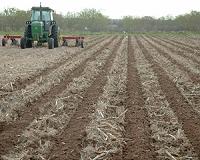 |
Manhattan KS (SPX) Jan 17, 2011 At any given time between 10 and 20 percent of cattle in the United States are afflicted with lameness, making it one of the most common ailments affecting feedlot and stocker calves. That's why a Kansas State University research team is working to reduce the percentage of cattle affected by bovine lameness. Three researchers - David Anderson, professor of clinical sciences; Brad White, associate professor of clinical sciences; and Johann Coetzee, associate professor of clinical sciences - are involved with bovine pain and welfare assessment at K-State's College of Veterinary Medicine. Because of their efforts to understand and treat lameness in cattle, they are becoming leaders in this critically important bovine research. "K-State is one of the few universities in the country with a farm animal surgery program," Anderson said. "Because of the research we're doing here, we're getting national and international attention about these programs." The team is developing a model to assess lameness and identify possible ways to treat it. Lameness can be excruciatingly painful for cattle and is caused by a variety of factors, including nutrition, environment and infectious organisms, Anderson said. When damage to the hoof and sole results in ulcers, abscesses or infection of the deep tissue of the foot, it causes severe pain during weight bearing. The goal of their research is to identify risk factors for the prevention of lameness, validate tools for early detection, develop recommendations for effective treatment, and ultimately improve the health and welfare of cattle. Each researcher is focusing on a different area of the project. Anderson is working on pressure map technology, which is a way of measuring the weight bearing and method of stride. White is working on accelerometry, which involves using monitors to measure the behavioral responses of animals. White can monitor an animal for 24 hours to determine how much time it spends lying down, moving around or standing still. Coetzee, a pharmacokinetic and pharmacodynamic specialist, is working to analyze indicators of pain in the blood and analyzing drugs to determine the dosage to reduce pain. So far the researchers have developed ways to assess lameness. They are now looking at therapeutic models and identifying drugs - such as flunixin and meloxicam - that could help ameliorate pain and lameness. The researchers recently published work on sodium salicylate in the Journal of Dairy Science and will have an upcoming article about flunixin in the American Journal of Veterinary Research, expected sometime in 2011. Anderson spoke at the 2010 World Buiatrics Congress in Santiago, Chile, about farm animal surgery and has been invited to speak at the 2012 World Buiatrics Congress in Portugal.
Share This Article With Planet Earth
Related Links Kansas State University Farming Today - Suppliers and Technology
 New Farming Method To Reduce Greenhouse Gases, Increase Farm Yields
New Farming Method To Reduce Greenhouse Gases, Increase Farm YieldsColumbia MO (SPX) Jan 17, 2011 U.S. agricultural practices create 58 percent of nitrous oxide in the world, which is the third most prevalent greenhouse gas in the atmosphere. Scientists believe nitrous oxide contributes to global warming about 300 times more than carbon dioxide. New practices and products have been introduced to address this issue, but farmers do not have the time or profit margins to experiment with i ... read more |
|
| The content herein, unless otherwise known to be public domain, are Copyright 1995-2010 - SpaceDaily. AFP and UPI Wire Stories are copyright Agence France-Presse and United Press International. ESA Portal Reports are copyright European Space Agency. All NASA sourced material is public domain. Additional copyrights may apply in whole or part to other bona fide parties. Advertising does not imply endorsement,agreement or approval of any opinions, statements or information provided by SpaceDaily on any Web page published or hosted by SpaceDaily. Privacy Statement |